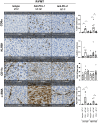Murine fecal microbiota transfer models selectively colonize human microbes and reveal transcriptional programs associated with response to neoadjuvant checkpoint inhibitors
- PMID: 35217892
- PMCID: PMC9411268
- DOI: 10.1007/s00262-022-03169-6
Murine fecal microbiota transfer models selectively colonize human microbes and reveal transcriptional programs associated with response to neoadjuvant checkpoint inhibitors
Abstract
Human gut microbial species found to associate with clinical responses to immune checkpoint inhibitors (ICIs) are often tested in mice using fecal microbiota transfer (FMT), wherein tumor responses in recipient mice may recapitulate human responses to ICI treatment. However, many FMT studies have reported only limited methodological description, details of murine cohorts, and statistical methods. To investigate the reproducibility and robustness of gut microbial species that impact ICI responses, we performed human to germ-free mouse FMT using fecal samples from patients with non-small cell lung cancer who had a pathological response or nonresponse after neoadjuvant ICI treatment. R-FMT mice yielded greater anti-tumor responses in combination with anti-PD-L1 treatment compared to NR-FMT, although the magnitude varied depending on mouse cell line, sex, and individual experiment. Detailed investigation of post-FMT mouse microbiota using 16S rRNA amplicon sequencing, with models to classify and correct for biological variables, revealed a shared presence of the most highly abundant taxa between the human inocula and mice, though low abundance human taxa colonized mice more variably after FMT. Multiple Clostridium species also correlated with tumor outcome in individual anti-PD-L1-treated R-FMT mice. RNAseq analysis revealed differential expression of T and NK cell-related pathways in responding tumors, irrespective of FMT source, with enrichment of these cell types confirmed by immunohistochemistry. This study identifies several human gut microbial species that may play a role in clinical responses to ICIs and suggests attention to biological variables is needed to improve reproducibility and limit variability across experimental murine cohorts.
Keywords: Biological variables; Fecal microbiota transfer; Gut microbiome; Immune checkpoint inhibitors; Lung cancer; Neoadjuvant.
© 2022. The Author(s), under exclusive licence to Springer-Verlag GmbH Germany, part of Springer Nature.
Conflict of interest statement
JRW reports equity ownership of Resphera Biosciences. JEC reports consultant fees for AstraZeneca, Bristol-Myers Squibb, Genentech, Merck, Flame Biosciences, Novartis, Regeneron, Guardant Health, and Jansen. JN reports research grants from Merck and AstraZeneca; consulting for AstraZeneca, Bristol-Myers Squibb, Takeda, Pfizer, Daiichi Sankyo, and Roche/Genentech; and honoraria from AstraZeneca and Bristol-Myers Squibb. PMF reports research grants from AstraZeneca, Bristol-Myers Squibb, Corvus, and Novartis. PMF reports consulting for Amgen, AstraZeneca, Bristol-Myers Squibb, Daiichi, Janssen, and Iteos. PMF reports serving as data safety monitoring board member for Flame Biosciences and Polaris. JEC reports consultant fees from AstraZeneca, Flame Biosciences, Genentech, Merck, Novartis, Jannsen. JDS has received consulting fees and honoraria from BMS, Merck, Roche, Amgen, AstraZeneca and Protalix Biotherapeutics; and he has received research grants from AstraZeneca, Merck, Roche and CLS therapeutics. JER has received advising/consulting fees from Oncocyte. DMP reports research support from AstraZeneca, Bristol Myers Squibb, and Compugen. DMP reports consulting for Aduro Biotech, Amgen, Astra Zeneca, Astellas, Bayer, Camden Partners, Compugen, DNAtrix, Dracen, Dynavax, Ervaxx, Five Prime Therapeutics, RAPT Therapeutics, Immunomic Therapeutics, Immunocore, Janssen, Merck, Potenza, Rock Springs Capital, Tizona, Trieza Therapeutics, Vaccitech, WindMil. DMP reports stock/ownership in Aduro Biotech, Dracen, Ervaxx, Five Prime Therapeutics, Tizona, Trieza Therapeutics, and WindMil. CLS reports research grants from Bristol-Myers Squibb and Janssen and personal fees from Ferring, outside the submitted work.
Figures







Similar articles
-
Conversion of unresponsiveness to immune checkpoint inhibition by fecal microbiota transplantation in patients with metastatic melanoma: study protocol for a randomized phase Ib/IIa trial.BMC Cancer. 2022 Dec 30;22(1):1366. doi: 10.1186/s12885-022-10457-y. BMC Cancer. 2022. PMID: 36585700 Free PMC article.
-
From chaos to order: optimizing fecal microbiota transplantation for enhanced immune checkpoint inhibitors efficacy.Gut Microbes. 2025 Dec;17(1):2452277. doi: 10.1080/19490976.2025.2452277. Epub 2025 Jan 18. Gut Microbes. 2025. PMID: 39826104 Review.
-
Interaction of bacterial genera associated with therapeutic response to immune checkpoint PD-1 blockade in a United States cohort.Genome Med. 2022 Mar 29;14(1):35. doi: 10.1186/s13073-022-01037-7. Genome Med. 2022. PMID: 35346337 Free PMC article.
-
Gut microbiome features associate with immune checkpoint inhibitor response in individuals with non-melanoma skin cancers: an exploratory study.Microbiol Spectr. 2025 Mar 4;13(3):e0255924. doi: 10.1128/spectrum.02559-24. Epub 2025 Feb 3. Microbiol Spectr. 2025. PMID: 39898646 Free PMC article.
-
Complex interactions between the microbiome and cancer immune therapy.Crit Rev Clin Lab Sci. 2019 Dec;56(8):567-585. doi: 10.1080/10408363.2019.1660303. Epub 2019 Sep 17. Crit Rev Clin Lab Sci. 2019. PMID: 31526274 Free PMC article. Review.
Cited by
-
Gut OncoMicrobiome Signatures (GOMS) as next-generation biomarkers for cancer immunotherapy.Nat Rev Clin Oncol. 2023 Sep;20(9):583-603. doi: 10.1038/s41571-023-00785-8. Epub 2023 Jun 26. Nat Rev Clin Oncol. 2023. PMID: 37365438 Free PMC article. Review.
-
Gut microbiota in hepatocellular carcinoma immunotherapy: immune microenvironment remodeling and gut microbiota modification.Gut Microbes. 2025 Dec;17(1):2486519. doi: 10.1080/19490976.2025.2486519. Epub 2025 Apr 1. Gut Microbes. 2025. PMID: 40166981 Free PMC article. Review.
-
The gut microbiome as a target in cancer immunotherapy: opportunities and challenges for drug development.Nat Rev Drug Discov. 2025 Sep;24(9):685-704. doi: 10.1038/s41573-025-01211-7. Epub 2025 Jun 2. Nat Rev Drug Discov. 2025. PMID: 40457025 Review.
-
Fecal Microbiome Composition Correlates with Pathologic Complete Response in Patients with Operable Esophageal Cancer Treated with Combined Chemoradiotherapy and Immunotherapy.Cancers (Basel). 2024 Oct 29;16(21):3644. doi: 10.3390/cancers16213644. Cancers (Basel). 2024. PMID: 39518082 Free PMC article.
-
Microbiota mechanisms in cancer progression and therapy.Cell Chem Biol. 2025 May 15;32(5):653-677. doi: 10.1016/j.chembiol.2025.04.005. Epub 2025 May 6. Cell Chem Biol. 2025. PMID: 40334660 Review.
References
-
- Brahmer J, Horn L, Jackman D, et al (2017) Abstract CT077: Five-year follow-up from the CA209–003 study of nivolumab in previously treated advanced non-small cell lung cancer (NSCLC): Clinical characteristics of long-term survivors. In: Cancer Research. American Association for Cancer Research (AACR), pp CT077–CT077
MeSH terms
Substances
Grants and funding
LinkOut - more resources
Full Text Sources
Medical
Research Materials

